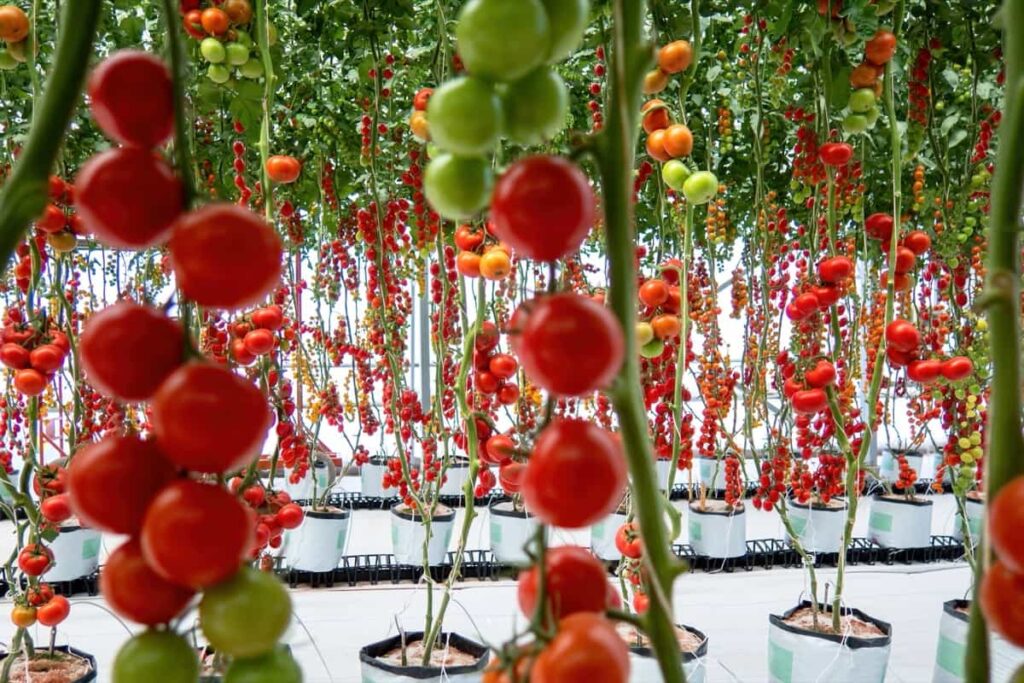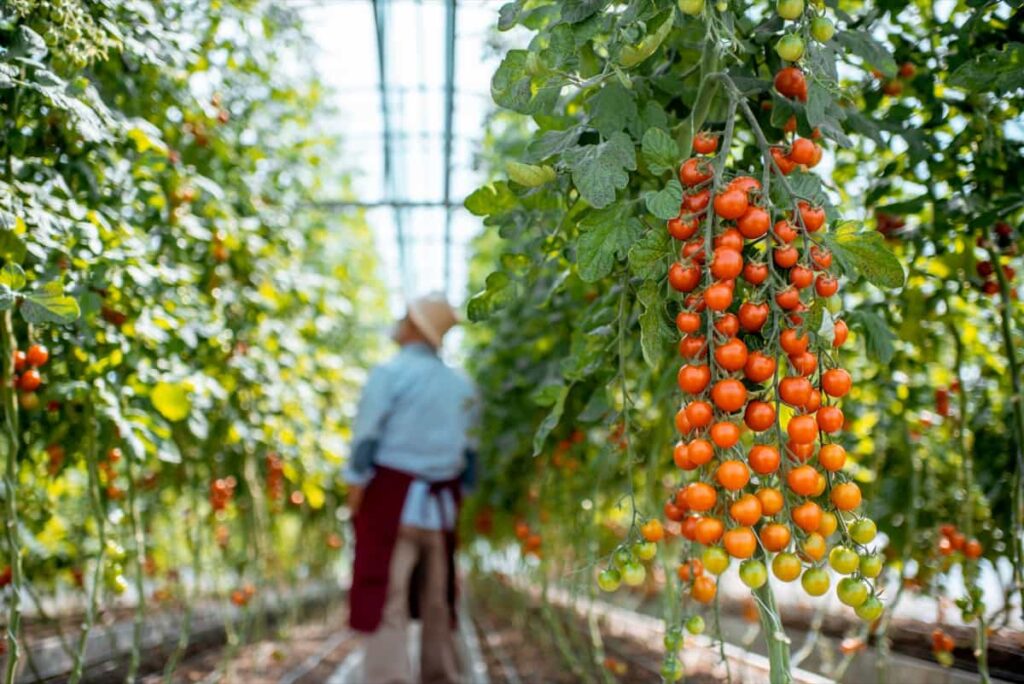Tomatoes are a popular fruit that many of us enjoy growing in our gardens. However, sometimes, we find ourselves disappointed with the size of our Tomato fruits. By using fertilizers, we can increase the size of Tomato fruits. These fertilizers play crucial roles in plant growth and development.

Best Fertilizers to Increase Tomato Fruit Size
Organic Tomato Fertilizer: Promoting Natural Growth
Fertilizers supply important nutrients such as nitrogen, phosphorus, and potassium (NPK), which are vital for fruit development. These nutrients promote cell division and enlargement within the plant, resulting in larger and more abundant Tomatoes. The nutrients in fertilizers support healthy plant growth by strengthening roots, stems, leaves, and flowers and ultimately improving fruit production.
Using an organic option can improve the taste and flavor profile of your Tomatoes. These fertilizers help the plants produce high-quality fruits that are bursting with delicious flavors. In addition to promoting natural growth in Tomatoes, organic fertilizers also contribute to overall sustainability practices in gardening.
Slow-Release Fertilizer: Long-lasting Nutrient Supply
Unlike traditional fertilizers that release their nutrients all at once, slow-release fertilizers provide a gradual and sustained nutrient supply over an extended period. This means that your Tomato plants can continuously access the elements they need to thrive and produce bountiful fruits.
The beauty of slow-release fertilizers lies in their ability to slowly break down and release nutrients based on environmental conditions such as temperature, moisture levels, and microbial activity. Furthermore, slow-release fertilizers are designed to improve soil health by promoting beneficial microbial activity. Using a slow-release fertilizer for your Tomatoes is an effective method to ensure a steady supply of nutrients throughout their growing season.
Balanced NPK Fertilizer: Optimal Nutrient Ratio
These fertilizers contain a well-balanced ratio of essential nutrients – NPK (nitrogen, phosphorus, and potassium) – that are vital for Tomato growth and development. One commonly used balanced NPK fertilizer ratio for Tomatoes is 10-10-10 or 5-10-10. The first number represents the percentage of nitrogen, which promotes overall plant vigor.
The second number signifies the percentage of phosphorus, which stimulates root development, flower formation, and fruit set. The third number indicates the percentage of potassium, which enhances fruit quality by improving flavor and color while also strengthening disease resistance.
Compost: Natural Soil Enrichment
Compost is an organic fertilizer that can greatly enhance Tomato plant productivity. It is made by decomposing organic matter, such as kitchen scraps, yard waste, and plant material. When used in gardening, compost acts as a soil amendment that improves its structure, water-holding capacity, and nutrient content.
In case you missed it: The Art of Heirloom Tomato Farming: Growing Rare and Delicious Varieties

Additionally, compost contributes to the overall health of the soil ecosystem by promoting beneficial microbial activity. Using compost reduces the use of chemical fertilizers while reducing waste sent to landfills. It’s an eco-friendly option that not only benefits your garden but also helps promote sustainability on a larger scale.
Fish Emulsion Fertilizer: Rich in Nutrients
Fish emulsion fertilizer is a fantastic option for boosting the growth and productivity of your Tomato plants. This organic fertilizer, made from decomposed fish remains, is incredibly rich in nutrients that Tomatoes need to thrive. The main benefit of using fish emulsion fertilizer for Tomatoes is its high nitrogen content. Nitrogen is essential for promoting strong leafy growth in plants, including Tomato vines. To use fish emulsion as a fertilizer for Tomatoes, dilute it with water according to the instructions on the product label. Then, apply it around the base of each plant or use it as a foliar spray for quicker absorption by leaves.
Bone Meal: Enhancing Flowering and Fruit Set
Derived from crushed animal bones, this organic fertilizer is rich in phosphorus, which plays an important role in promoting healthy flower development and increasing fruit production. By adding bone meal to your Tomato plants, you are providing them with the necessary nutrients they need to thrive.
Phosphorus helps stimulate root growth, ensuring that your plants can absorb water and nutrients efficiently. This ultimately leads to stronger stems and healthier foliage. To use bone meal on your Tomato plants, sprinkle a handful around each plant’s base when planting or during the growing season. Be sure not to overdo it, though; too much phosphorus can be detrimental to your plants.
Seaweed Extract: Stimulating Growth and Productivity
When applied to Tomato plants, seaweed extract stimulates their growth by providing them with the necessary minerals they need to thrive. It enhances nutrient uptake in the roots, allowing the Tomato plants to absorb water and nutrients from the soil. Not only does seaweed extract promote growth, but it also improves overall plant health and resilience. The hormones present in seaweed help strengthen the plants’ immune, making them more resistant to diseases and pests. Additionally, seaweed extract increases productivity by encouraging flower production and fruit set in Tomato plants.
Epsom Salt: Magnesium Boost for Tomatoes
This natural mineral compound contains magnesium and sulfur, two essential nutrients that Tomatoes need for optimal development. Additionally, magnesium deficiency can lead to yellowing leaves and poor fruit set in Tomatoes. By using Epsom salt as a Tomato fertilizer, you can promote healthy foliage and abundant harvests. Using Epsom salt is easy –dissolve one tablespoon of it in a gallon of water and apply it to the base of your Tomato plants once every 2 weeks during the growing season. Remember not to overdo it, though; too much magnesium can have adverse effects on plant growth.
Liquid Kelp Fertilizer: Nutrient-Rich Plant Tonic
To apply liquid kelp fertilizer effectively, dilute it according to the instructions on the packaging and spray or water around the base of your Tomato plants. The main benefit of using liquid kelp fertilizer for Tomatoes is its ability to stimulate root development. Liquid kelp fertilizer enhances the plant’s resistance to stressors such as drought, disease, and pests.
In case you missed it: 14 Steps to Start Tomato Farming in the Netherlands: Yield per Hectare and Dutch Tomato Varieties

Strengthening the Tomato plants’ immune system ensures that they thrive even in challenging conditions. Furthermore, this nutrient-rich tonic contains an array of micronutrients that are often lacking in traditional fertilizers. These micronutrients play a major role in supporting healthy foliage development and improving the flavor profile of Tomatoes.
Worm Castings: Soil Enrichment and Nutrient Cycling
Worm castings provide essential nutrients that Tomatoes need to thrive. Additionally, worm castings also introduce beneficial microbes into the soil, which aid in nutrient absorption by plants. To use worm castings as fertilizer for your Tomatoes, mix them into the top few inches of soil around each plant or incorporate them when preparing your garden bed before planting.
Best Time to Apply Fertilizers to Increase Tomato Fruit Size
| Best Fertilizers | Best Time to Apply |
| Organic Tomato Fertilizer | Early Spring and every 4-6 weeks |
| Slow-Release Fertilizer | Before planting and once during mid-season |
| Balanced NPK Fertilizer | Shortly after transplanting and throughout the growing season |
| Compost | Before planting as a soil amendment or side dressing every few weeks |
| Fish Emulsion Fertilizer | Every two weeks during active growth periods until fruit set |
| Bone Meal | Sprinkle around plants before flowering begins in early summer |
| Seaweed Extract | As a foliar spray during early morning or late afternoon |
| Epsom Salt | Dissolve in water and apply when fruits are forming |
| Liquid Kelp Fertilizer | Once a month from Spring through fall |
| Worm Castings | Mix into soil prior to planting or use as a top dressing |
Frequently Asked Questions (FAQ) on Tomato Plant Fertilizers
How Do Fertilizers Affect Tomato Fruit Size?
Fertilizers play a major role in determining the size of your Tomatoes. They provide essential nutrients that are necessary for plant growth and development. When Tomato plants receive an adequate nutrient supply, they can allocate more energy towards producing larger fruits.
In case you missed it: Pests Affecting Tomato Crops at Flowering Stage: Symptoms, Control, and Prevention

Can Over-Fertilization Harm My Tomato Plants?
Yes. Over-fertilization can affect excessive vegetative growth at the expense of fruit production or even burn the roots if too much chemical fertilizer is applied.
What Are Some Signs That My Tomatoes Need More Fertilizer?
Yellowing leaves, stunted growth, and low yields could indicate a lack of nutrients. Conducting soil tests can help determine which specific nutrients are important for Tomato plant growth.
Conclusion
Fertilizers play an important role in enhancing the size, yield, and taste of Tomatoes. They act as a nutritional boost for Tomatoes, enabling them to produce larger fruits that are packed with flavor. Moreover, fertilizers contribute to increased yields by promoting fruit sets in Tomato plants.
- Crops Grown in Summer Season: Best Choices for Summer Gardening
- Organic Pest Control for Tomato Farming
- How to Maximize Sheep Farming Profit
- Broccoli Varieties: Choosing the Right Cultivars for Your Farm
- How to Raise Pigs in Your Own Backyard: A Comprehensive Guide
- Budget Friendly Sheep Shed Ideas: Cheap and Low-Cost Tips
- How Much Do Cattle Farmers Make: Revenue Streams in Cattle Farming
- Management Pests and Diseases in Your Cotton Field
- Sheep Farming Business Plan for Beginners
